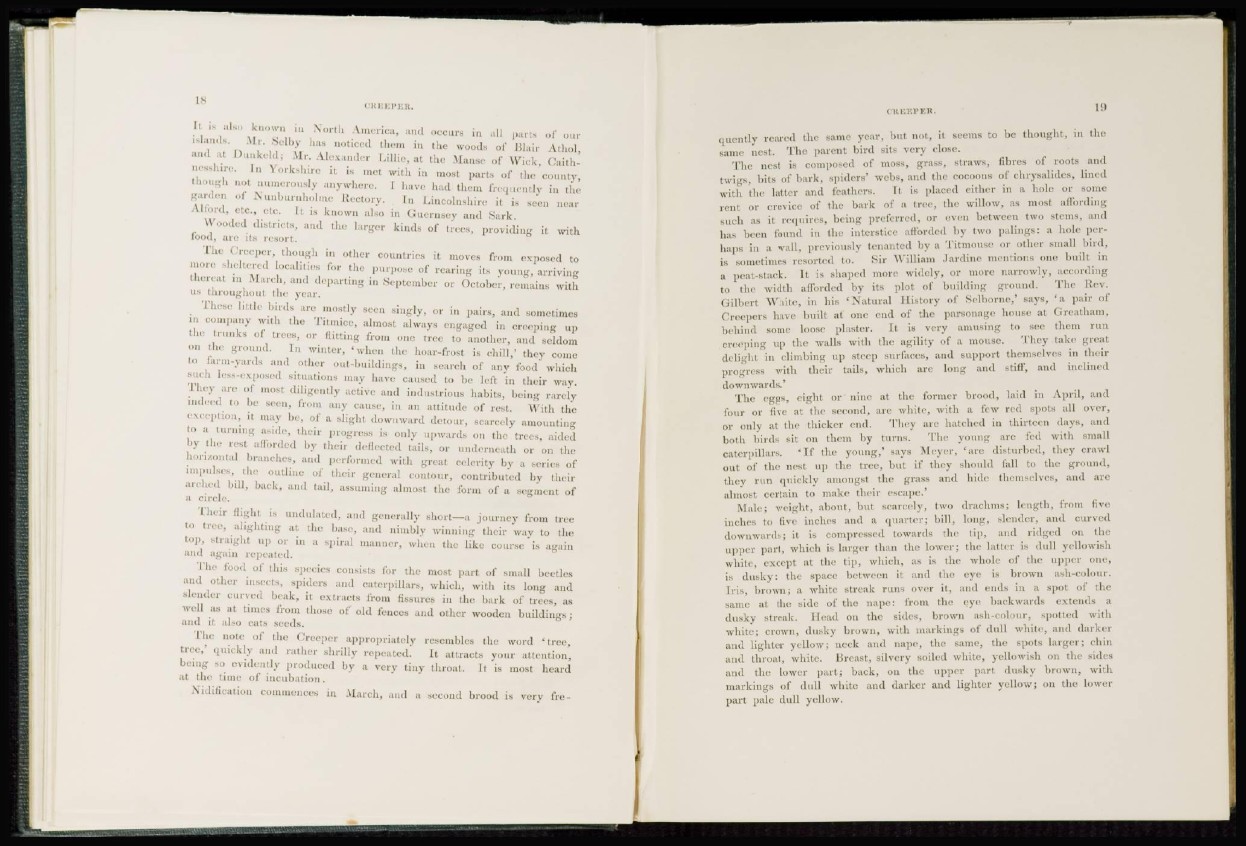
' 1!» I PER.
It ¡8 also known in North America, and occurs in -ill parts of our
islands. Mr. Selby lias noticed them in the woods of Blair Athol,
and at Duukcld; Mr. Alexander Lillie, at the Manse of Wick, Caithnesshire.
In Yorkshire il is met with in most parts of the county,
though not numerously anywhere. I have had them frequently in the
garden of Nunburnholme Rectory. In Lincolnshire it is seen near
All'ord, etc., etc. It is known also in Guernsey and Nark.
Wooded districts, and the larger kinds of trees, providing it with
food, are its resort.
The Creeper, though in other countries it mores from exposed to
more sheltered localities tor the purpose of rearing its young, arriving
thereat in March, and departing in September or October, remains with
us throughout the year.
These little birds are mostly seen singly, or in pairs, and sometimes
in company with the Titmice, almost always engaged in creeping up
the trunks of trees, or flitting from one tree to another, and seldom
on the ground. In winter, 'when the hoar-frost is chill,1 they come
to farm-yards and other out-buildings, in search of any food which
such less-exposed situations may have caused to be left in their way.
They are of most diligently active and industrious habits, being rarely
indeed to he seen, from an} cause, in an attitude of' rest. With the
exception, it may he, ol a slight downward detour, scarcely amounting
to a turning aside, their progress is only upwards on the trees, aided
by the rest afforded by their deflected tails, or underneath or on the
horizontal branches, and performed with great celerity by a scries of
impulses, the outline of their general contour, contributed by their
arched bill, back, ami tail, assuming almost the form of a segment of
a circle.
Their flight is undulated, and generally short—a journey from tree
to tree, alighting at the base, and nimbly winning their way to the
top, straight up or in a spiral manner, when the like course is again
and again repeated.
The food of this species consists for the most part of small beetles
and oilier insects, spiders and caterpillars, which, with it> long and
slender curved beak, it extracts from fissures in the bark of trees, as
well as at times from those of old fences and other wooden buildings;
and it also eats seeds.
The note of the Creeper appropriately resembles the word 1 tree,
tree,' quickly and rather shrilly repeated. It attracts your attention,
being so evidently produced by a very tiny throat. It is most heard
at the time of incubation.
N'iditication commences in March, and a second brood is very Been
EEPER. 19
quently reared the same year, but not, it seems to be thought, in the
same nest. The parent bird sits very close.
The nest is composed of moss, grass, straws, fibres of roots and
twigs, bits of bark, spiders" webs, and the cocoons of chrysalides, lined
witli the latter and feathers. It is placed cither in a hole or some
rent or cre\ ice of t hi' bark of a tree, the willow, as most affording
such as it requires, being preferred, or even between two stems, and
\\,i< hem found in the interstice afforded by two palings: a hole perhaps
in a wall, previously tenanted by a Titmouse or other small bird,
is sometimes resorted to. Sir William Jardine mentions one built in
a prat-stack. It is shaped more widely, or more narrowly, according
to the width afforded by its plot of building ground. The Key.
Gilbert White, in his 'Natural History of Selborne,' says, ' a pair of
Creepers have built at one end of the parsonage house at (Ireatham,
behind some loose plaster. It is very amusing to see them run
creeping up the walls with the agility of a mouse. They take great
delight in climbing up steep surfaces, and support themselves in their
progress with their tail-, which are long and Stiff, and inclined
downwards.9
The eggs, eighl or nine at the former brood, laid in April, and
four or five at the second, arc white, with a few red spots all over,
or only at the thicker end. They are hatched in thirteen days, and
both birds sii on them by turns. The young are fed with small
caterpillars. 'If the young,' says Meyer, 'are disturbed, they crawl
out of the nest up the tree, hut if they should fall to the ground,
they run quickly amongst the grass and hide themselves, and are
almost certain to make their escape.'
Male; weight, about, but scarcely, two drachms; length, from five
inches to five inches and a quarter; bill, long, slender, and curved
downwards; it is compressed towards the tip, and ridged on the
upper part, which is larger than the lower; the latter is dull yellowish
white, except at the tip, winch, as is the whole of the upper one,
is dusky: the space between it and the eye is brown ash-colour.
Iris, brown; a white streak runs over it, and ends in a spot of the
same at the side of the uape: from the eye backward- extends a
dusky streak. Head on the sides, brown ash-colour, spotted with
white; crown, dusky brown, with markings of dull white, and darker
and lighter yellow; neck and nape, the same, the spots larger; chin
and throat, white. Breast, silvery soiled white, yellowish on the sides
and the lower part; back, on the upper part dusky brown, with
markings of dull while and darker and lighter yellow; on the lower
part pale dull yellow.